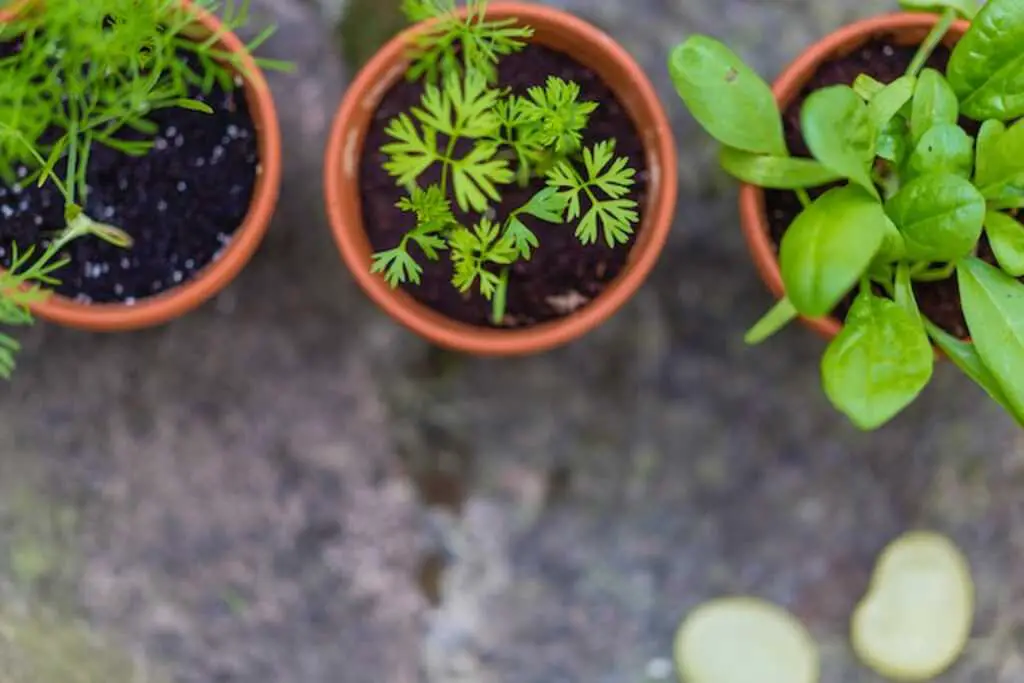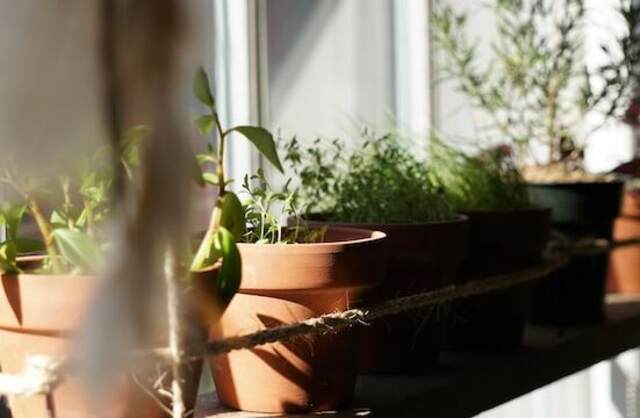Growing Herbs in Pots For Beginners: Expert Advice!
In this guide, we’ll walk you through all the basics of growing herbs in pots for beginners, from choosing the right herbs for your pot to common problems and solutions.
By the end of this article, you’ll have all the information you need to start growing your own herbs and enjoy the freshness and flavor they bring to your meals. So let’s get growing!
Table of Contents
- 1 What is Growing Herbs, and Why Should You Do It?
- 2 1. What You’ll Need to Get Started Growing Herbs in Pots
- 3 Selecting the Right Pot Size for Your Herbs
- 4 2. Preparing Your Pot for Planting
- 5 3. Choosing the Right Herbs for Your Pot
- 6 4. The Best Soil for Growing Herbs in Pots
- 7 5. Watering and Fertilizing Your Herbs
- 8 6. Best Practices for Pruning and Harvesting Herbs in Pots
- 9 7. Common Problems and Solutions When Growing Herbs in Pots
- 10 8. Tips for Growing Herbs Successfully in Pots
- 11 FAQs: Growing Herbs in Pots For Beginners
- 11.1 What herbs can I grow in pots?
- 11.2 What type of pot should I use?
- 11.3 What type of soil should I use?
- 11.4 How often should I water my herbs?
- 11.5 How much sunlight do my herbs need?
- 11.6 How often should I fertilize my herbs?
- 11.7 How do I prune my herbs?
- 11.8 Can I grow herbs indoors?
- 11.9 How do I prevent pests and diseases?
- 11.10 Can I harvest my herbs right away?
- 12 Conclusion: The Benefits of Growing Herbs in Pots
- 13 Author
What is Growing Herbs, and Why Should You Do It?
Growing herbs in pots is a great way to add flavor and nutrition to your meals and to your life! Herbs are easy to grow and provide many health benefits. Plus, you don’t need a huge garden or even a lot of space to get started. All you need is a pot, some soil, and a few herbs.
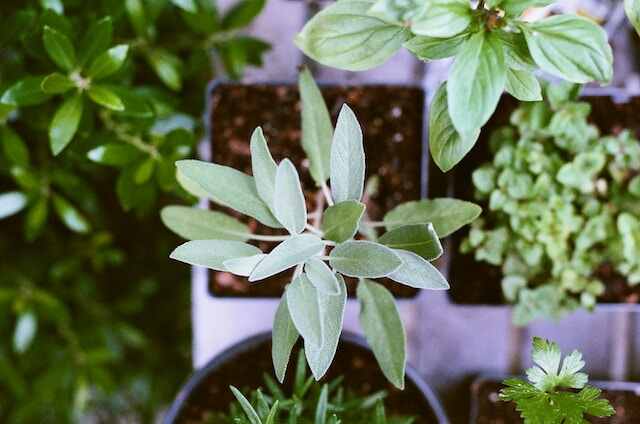
1. What You’ll Need to Get Started Growing Herbs in Pots
Before you get started growing herbs in pots, there are a few things you’ll need to make sure you have on hand. First, you’ll need a pot or container that’s suitable for the herbs you’d like to grow.
The size and material of the pot will depend on what type of herbs you plan to grow, so research the best option for your particular herbs. You’ll also need soil specifically designed for container gardening, as regular garden soil won’t work in this case.
Additionally, you’ll need some tools to help you with planting, pruning and harvesting your herbs. These may include a trowel, pruning shears, and a harvesting knife.
Finally, you’ll need to make sure you have plenty of water and fertilizer on hand to give your herbs the nutrients they need to thrive. With these supplies, you’ll be ready to start growing herbs in pots!
| Item | Description |
|---|---|
| Pot or container | Suitable size and material for the herbs you want to grow |
| Soil | Specifically designed for container gardening |
| Tools | Trowel, pruning shears, and a harvesting knife |
| Water | To keep the herbs hydrated |
| Fertilizer | To provide nutrients for healthy growth |
Selecting the Right Pot Size for Your Herbs
One of the most important considerations when growing herbs in pots is selecting the right pot size. The size of the pot you choose will depend on the type of herb you are growing and how much space it needs to thrive.
As a general rule of thumb, small herbs like basil and cilantro can be grown in pots that are 6–8 inches in diameter, while larger herbs like rosemary and thyme may need pots that are 10–12 inches in diameter or larger.
However, it’s important to do your research and check the specific requirements for each herb you plan to grow. It’s also important to consider the depth of the pot. Most herbs have relatively shallow root systems, so a pot that is 6–8 inches deep is usually sufficient.
However, if you’re growing herbs like lemongrass or fennel that have deeper root systems, you may need a deeper pot.
Keep in mind that larger pots can hold more soil and moisture, which can be beneficial for herbs that need consistent moisture. However, larger pots can also be heavier and more difficult to move around, so consider the practicality of the pot size you choose.
Ultimately, selecting the right pot size for your herbs is an important step in ensuring their success.
By choosing a pot that is the right size for your specific herbs, you can help them grow and thrive in their new home.
| Pot Size (inches) | Suitable Herbs |
|---|---|
| 6-8 inches | Basil, Cilantro, Parsley, Chives, Dill, Oregano, Sage, Thyme, Mint |
| 10-12 inches or larger | Rosemary, Lavender, Bay, Lemongrass, Tarragon, Fennel, Chamomile, Marjoram, Catnip, Stevia, Lemon Balm, Lovage |
2. Preparing Your Pot for Planting
Prepping your pot for planting is an important step in growing herbs in pots, and it can make all the difference in the success of your herb garden. Before you add soil and plants to your pot, you’ll want to make sure it’s ready for planting.
First, you’ll need to make sure your pot has drainage holes in the bottom. Without these, excess water won’t be able to escape, and your herbs will be prone to root rot. Next, you’ll want to line the bottom of the pot with a layer of stones or pebbles to help with drainage.
This will help prevent the soil from becoming too soggy. Finally, it’s a good idea to give your pot a thorough cleaning with soapy water and a brush before you start planting. This will get rid of any dirt, debris, or pests that may be lurking in the pot.
Once your pot is prepped and ready, you can start planting your herbs!
| Step | Action |
|---|---|
| 1. | Make sure your pot has drainage holes in the bottom. |
| 2. | Line the bottom of the pot with a layer of stones or pebbles to help with drainage. |
| 3. | Give your pot a thorough cleaning with soapy water and a brush to get rid of any dirt, debris, or pests. |
| 4. | Add potting soil to your pot, leaving a little room at the top for watering. |
| 5. | Create a small hole in the soil for each herb you plan to plant. |
| 6. | Gently remove the herb from its current container, loosen any compacted roots, and place it in the hole. |
| 7. | Fill in the space around the herb with soil and lightly press down. |
| 8. | Water your newly potted herbs and place the pot in a location with appropriate sunlight and temperature for your herbs. |
Remember, proper preparation of your pot is key to healthy herb growth, so take your time and make sure your pot is ready for planting before adding soil and plants.
3. Choosing the Right Herbs for Your Pot
Choosing the right herbs for your pot can be the difference between success and failure in growing herbs in pots. With so many different herbs to choose from, it can be overwhelming to decide which herbs will work best for your particular pot.
Before making a selection, it’s important to consider the size of your pot and the climate conditions of your location. Some herbs are better suited to cooler climates, while others need more heat.
It’s also a good idea to think about what you’d like to use the herbs for, whether it’s for cooking, medicinal purposes, or for adding a pleasant scent to your home. If you’re looking for something easy to start with, there are a few herbs that are perfect for beginners.
These include chives, oregano, basil, parsley, thyme, and dill. All of these herbs are hardy and resilient and can handle a bit of neglect.
If you’re looking for something more exotic, there’s a wide range of herbs available, including mint, rosemary, lavender, and sage. Once you’ve selected the herbs that you’d like to grow, it’s time to prepare the soil.
| Herb | Pot Size | Climate Conditions | Common Uses |
|---|---|---|---|
| Chives | Small to Medium | Cool to Warm | Cooking, Garnish |
| Oregano | Small to Medium | Warm | Cooking, Medicinal |
| Basil | Medium | Warm | Cooking |
| Parsley | Small to Medium | Cool | Cooking, Medicinal |
| Thyme | Small to Medium | Cool to Warm | Cooking, Medicinal |
| Dill | Medium | Cool to Warm | Cooking, Pickling |
| Mint | Medium to Large | Cool to Warm | Cooking, Tea, Medicinal |
| Rosemary | Medium to Large | Warm | Cooking, Medicinal |
| Lavender | Medium to Large | Warm | Fragrance, Medicinal |
| Sage | Medium to Large | Warm | Cooking, Medicinal |
4. The Best Soil for Growing Herbs in Pots
When it comes to growing herbs in pots, the soil you use is just as important as the pot you choose. It’s essential to pick the right mix of soil to ensure your herbs can thrive in their new home.
Soil for growing herbs in pots should be lightweight, well-draining, and slightly acidic. It should be able to hold onto moisture, but not be soggy. A good potting soil should have a mix of peat moss, vermiculite, and perlite, which can be found in most garden stores.
When it comes to herbs, you may also want to purchase a soil specifically designed for herbs, which can be found in most garden stores as well.
If you’re feeling creative, you can also create your own potting mix! Start with a base of equal parts compost, topsoil, and perlite, and then add a small amount of peat moss. You can also mix in a bit of sand, if you’d like.
No matter what type of soil you choose, it’s important to make sure you purchase enough for the number of pots you have.
You’ll also want to ensure that your soil is fresh and hasn’t been sitting around for too long, as old soil can lose its nutrients and become compacted.
Additionally, it’s a good idea to mix in some slow-release fertilizer into your soil to give your herbs a boost of nutrients throughout the growing season, but well go over that in the nest step.
Overall, choosing the right soil is crucial for the success of your potted herb garden, so take the time to do your research and find the best option for your specific herbs and growing conditions.
| Soil Type | Characteristics | Suitable Herbs |
|---|---|---|
| Lightweight, well-draining soil | Should be slightly acidic | Most herbs, including basil, rosemary, and thyme |
| Potting soil for herbs | Specifically designed for herbs, contains mix of peat moss, | Most herbs, including basil, rosemary, and thyme |
| vermiculite, and perlite | ||
| Homemade potting mix | Equal parts compost, topsoil, and perlite, small amount of | Most herbs, including basil, rosemary, and thyme |
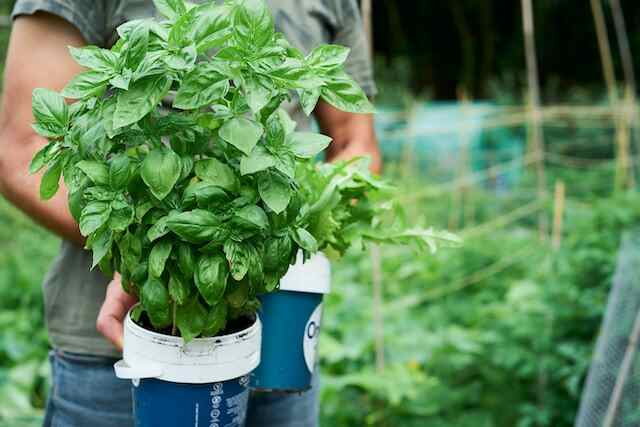
5. Watering and Fertilizing Your Herbs
Watering and fertilizing your herbs are essential parts of growing them in pots. It is important to keep your soil moist and give your plants enough water to grow.
You should water your herbs in the morning, so that the water has time to soak in before the hot sun can evaporate it.
For most herbs, you should water them until the soil is moist but not soggy. You should also fertilize your herbs to give them the necessary nutrients for healthy growth.
Choose a fertilizer that is specifically designed for herbs and follow the directions on the package. Fertilize your herbs every few weeks, or as needed.
| Task | Frequency | Tips |
|---|---|---|
| Watering | Daily or as needed | Water in the morning and stop when the soil is moist but not soggy. |
| Fertilizing | Every few weeks or as needed | Use a fertilizer specifically designed for herbs and follow package directions. |
6. Best Practices for Pruning and Harvesting Herbs in Pots
Pruning and harvesting your herbs in pots is an important part of the growing process. If done correctly, you can maximize the yield and flavor of your herbs.
When pruning, use sharp pruners or scissors to cut back leaves and stems to promote new growth and encourage bushier plants.
Make sure to prune the top of the plant to encourage lateral growth. When harvesting, you want to make sure you don’t take too much off at once.
Start by taking just a few leaves or stems, which will leave enough of the plant to continue growing. You can also harvest the entire plant if needed.
Make sure to harvest early in the morning when the herbs are at their peak flavor. This will ensure the best taste and most nutrients.
Use the herbs you harvest right away, or store them in a cool, dry place.
| Practice | Description |
|---|---|
| Use sharp pruners or scissors | Using sharp tools will ensure clean cuts, preventing damage to the plant and reducing the risk of disease. |
| Cut back leaves and stems to promote new growth | Pruning promotes new growth and encourages bushier plants. Cutting back dead or damaged parts of the plant also helps maintain plant health. |
| Prune the top of the plant to encourage lateral growth | Cutting back the top of the plant will encourage lateral growth, creating a bushier plant with more stems and leaves. |
| Take only a few leaves or stems when harvesting | Harvesting just a few leaves or stems at a time ensures that enough of the plant is left to continue growing. This also reduces the risk of damaging the plant or slowing down its growth. |
| Harvest early in the morning | Herbs are at their peak flavor and nutrient content early in the morning. Harvesting at this time will ensure the best taste and most nutrients in your herbs. |
| Use harvested herbs right away or store properly | Using your harvested herbs right away ensures the best flavor and nutrient content. However, if you need to store them, make sure to do so properly. Store them in a cool, dry place, such as a refrigerator or airtight container. |
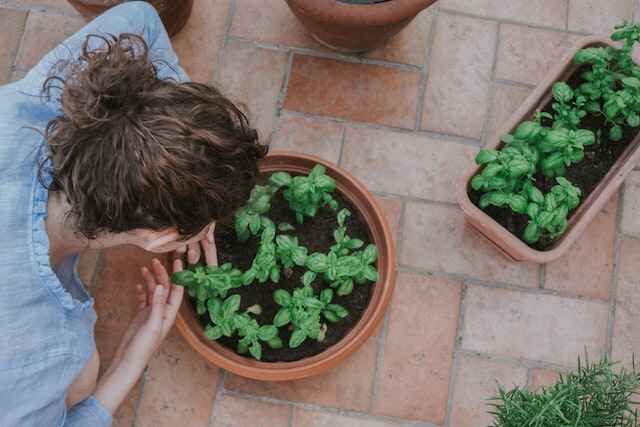
7. Common Problems and Solutions When Growing Herbs in Pots
Growing herbs in pots can sometimes lead to common problems that can be difficult to diagnose and fix. These problems may include wilting and yellowing of leaves, poor growth, and weak or stunted plants.
Fortunately, there are some common problems and solutions when growing herbs in pots that can help you get your herbs back to looking and thriving their best. One common problem is when the soil in the pot becomes too dry.
When the soil dries out, the herbs won’t be able to get the moisture they need to survive. To fix this problem, simply water the soil, making sure it is consistently damp but not soggy.
Another common problem is over-fertilizing. When you fertilize your herbs, be sure to follow the instructions on the packaging, as over-fertilizing can burn or even kill your herbs. If you suspect that you’ve over-fertilized, flush the soil with plenty of water.
If your herbs are looking wilted or yellow, they may be suffering from a lack of sunlight. To fix this, move the herbs to a brighter spot and make sure they get plenty of direct sunlight.
Finally, if you notice any pests or diseases on your herbs, it’s important to address the issue as soon as possible to prevent further damage.
Some common pests that may affect herbs in pots include spider mites, aphids, and whiteflies, while diseases such as powdery mildew and root rot can also be problematic.
To address these issues, you may need to use insecticidal soaps, neem oil, or other natural or chemical treatments, depending on the severity of the infestation or infection. Regularly inspecting your herbs for signs of pests or diseases and addressing them promptly can help prevent further damage and keep your herbs healthy and thriving in their pots.
| Problem | Solution |
|---|---|
| Soil becomes too dry | Water the soil to keep it consistently damp |
| Over-fertilizing | Flush the soil with plenty of water |
| Lack of sunlight | Move the herbs to a brighter spot with direct sun |
| Pests (e.g. spider mites, | Use insecticidal soaps, neem oil, or other natural |
| aphids, whiteflies) | or chemical treatments to address the issue |
| Diseases (e.g. powdery | Use natural or chemical treatments depending on |
| mildew, root rot) | the severity of the infection or infestation |
| Regularly inspect herbs for signs of pests or | |
| diseases and address them promptly |
8. Tips for Growing Herbs Successfully in Pots
Growing herbs in pots can be a great way to get started with gardening. With the right tips and tricks, you can get the most out of your herb garden. Here are some tips for growing herbs successfully in pots:
- Start with a good potting mix. A potting mix that contains compost, peat moss, and perlite is ideal for growing herbs.
- Make sure your pot has good drainage. If the pot does not have good drainage, it may become waterlogged and your herbs will suffer.
- Choose the right herbs for your pot. Some herbs, like basil, can be grown in smaller pots while others, like rosemary, need more space.
- Make sure your pot gets enough light. Herbs need at least six hours of sunlight a day in order to grow properly.
- Prune your herbs regularly. Pruning your herbs will help keep them healthy and encourage growth.
- Water your herbs regularly. Make sure your herbs get enough water, but don’t over water them.
- Fertilize your herbs. Fertilizing your herbs will help them grow healthy and strong.
- Harvest your herbs regularly. Regularly harvesting your herbs.
| Tips for Growing Herbs Successfully in Pots | Tips | Additional Information |
|---|---|---|
| Start with a good potting mix | Use a potting mix that contains compost, peat moss, and perlite. | These ingredients provide good drainage and nutrients for the herbs. |
| Make sure your pot has good drainage | Choose a pot with drainage holes or add rocks to the bottom of the pot. | Good drainage is crucial to prevent waterlogging and root rot. |
| Choose the right herbs for your pot | Consider the growth habits and space requirements of different herbs. | Some herbs, like basil, can be grown in smaller pots while others, like rosemary, need more space. |
| Make sure your pot gets enough light | Place the pot in a sunny location that receives at least six hours of sunlight per day. | Herbs need adequate sunlight to grow properly. |
| Prune your herbs regularly | Use sharp pruning shears to remove dead or yellow leaves and promote bushy growth. | Pruning also helps prevent overcrowding and disease. |
| Water your herbs regularly | Water the herbs when the top inch of soil feels dry to the touch. | Avoid overwatering, which can cause root rot and other problems. |
| Fertilize your herbs | Use a balanced fertilizer once a month or as directed on the label. | Fertilizer provides essential nutrients for healthy growth. |
| Harvest your herbs regularly | Pinch off or cut leaves and stems as needed for cooking or to prevent flowering. | Regular harvesting encourages bushy growth and prolongs the plant’s lifespan. |
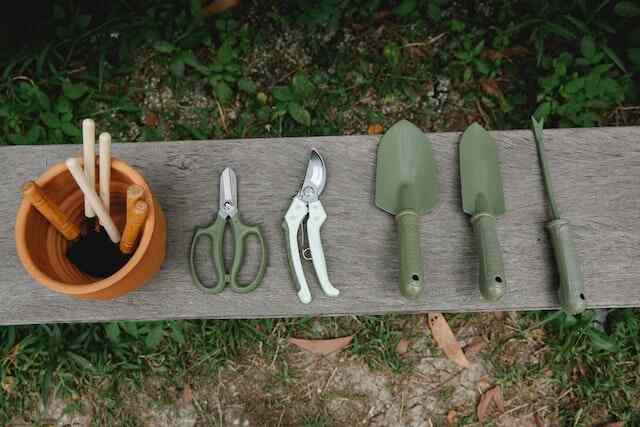
FAQs: Growing Herbs in Pots For Beginners
What herbs can I grow in pots?
You can grow a wide variety of herbs in pots, including basil, mint, parsley, thyme, oregano, rosemary, sage, and cilantro.
What type of pot should I use?
Choose a pot that is at least 6-8 inches in diameter and has drainage holes at the bottom. Ceramic, terra-cotta, ceramic, and plastic pots are all good options.
What type of soil should I use?
Use a lightweight, well-draining potting soil that is slightly acidic and can hold onto moisture without becoming soggy.
How often should I water my herbs?
In order to prevent root rot, it is recommended to water your herbs only when the top layer of soil feels dry to the touch. It is important to avoid overwatering.
How much sunlight do my herbs need?
Most herbs need at least 6 hours of sunlight per day, but some, like mint and parsley, can tolerate partial shade.
How often should I fertilize my herbs?
Fertilize your herbs with a slow-release fertilizer every 4-6 weeks during the growing season.
How do I prune my herbs?
Pinch off the tips of your herbs regularly to encourage bushy growth. Remove any dead or yellowing leaves to keep your herbs healthy.
Can I grow herbs indoors?
Yes, you can grow herbs indoors as long as they have access to plenty of sunlight or artificial light and are planted in a well-draining potting mix.
How do I prevent pests and diseases?
Keep your herbs healthy by providing them with proper sunlight, water, and nutrients. If you do notice pests or diseases, treat them promptly with an organic insecticide or fungicide.
Can I harvest my herbs right away?
It’s best to wait until your herbs are at least 6 inches tall before harvesting. Pinch off the tips of the stems regularly to encourage bushy growth, and only harvest up to one-third of the plant at a time to ensure healthy regrowth.
Conclusion: The Benefits of Growing Herbs in Pots
Growing herbs in pots is an incredibly rewarding experience. Not only do you get to enjoy the fresh flavor of your own hand-grown herbs, but you can also tailor your herb garden to perfectly fit your kitchen and lifestyle.
Growing herbs in pots also has many practical benefits, such as saving space in your garden, providing easy access to the herbs you use most frequently, and ensuring a plentiful harvest.
Plus, with a little bit of know-how and the right tools, growing herbs in pots is surprisingly easy and accessible. With a few simple steps, you can enjoy the many benefits of growing herbs in pots and get ready to reap the rewards of your own homegrown herbs!
Related Post: 8 Best Pots for Growing Herbs Outdoors (Rated For 2022)

